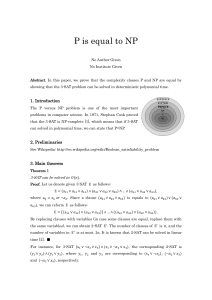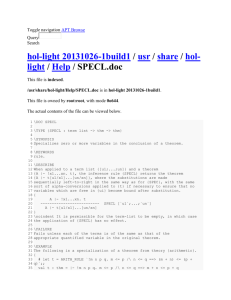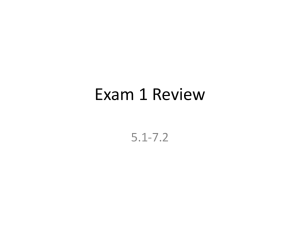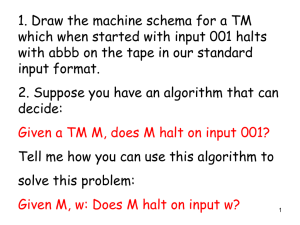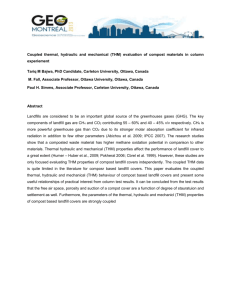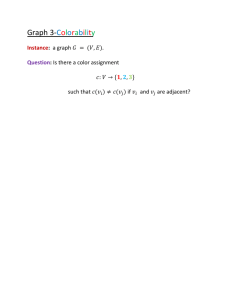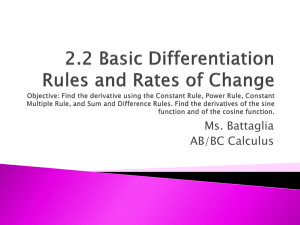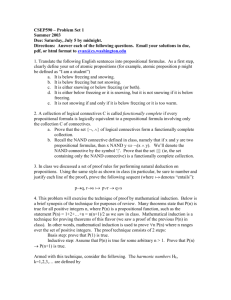Powerpoint - IAS - Institute for Advanced Study
advertisement
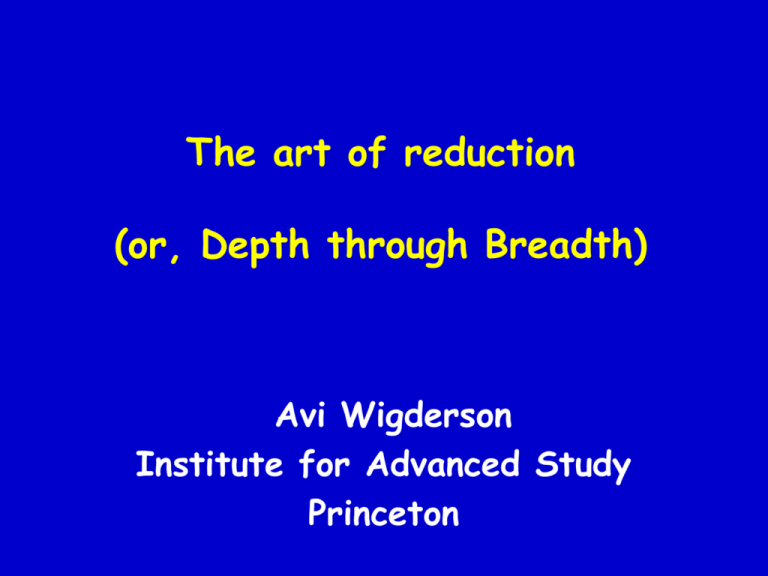
The art of reduction (or, Depth through Breadth) Avi Wigderson Institute for Advanced Study Princeton How difficult are the problems we want to solve? Problem A ? Problem B ? Reduction: An efficient algorithm for A implies an efficient algorithm for B If A is easy then B is easy If B is hard then A is hard Constraint Satisfaction I AI, Operating Systems, Compilers, Verification, Scheduling, … 3-SAT: Find a Boolean assignment to the xi which satisfies all constraints (x1x3 x7) (x1x2 x4) (x5x3 x6) … 3-COLORING: Find a vertex coloring using which satisfies all constraints Classic reductions Thm[Cook, Levin ’71] 3-SAT is NP-complete Thm[Karp 72]: 3-COLORING is NP-complete Proof: If 3-COLORING easy then 3-SAT easy formula graph x y satisfying legal assignment coloring Claim: In every legal 3-coloring, z = x y T F x y z OR-gadget NP - completeness Papadimutriou: “The largest intellectual export of CS to Math & Science.” “2000 titles containing ‘NP-complete’ in Physics and Chemistry alone” “We use it to argue computational difficulty. They to argue structural nastiness” Most NP-completeness reductions are “gadget” reductions. Constraint Satisfaction II AI, Programming languages, Compilers, Verification, Scheduling, … 3-SAT: Find a Boolean assignment to the xi which satisfies most constraints (x1x3 x7) (x1x2 x4) (x5x3 x6) … Trivial to satisfy 7/8 of all constraints! (simply choose a random assignment) How much better can we do efficiently? Hardness of approximation Thm[Hastad 01] Satisfying 7/8+ fraction of all constraints in 3-SAT is NP-hard Proof: The PCP theorem [Arora-Safra, Arora-Lund-Motwani-Sudan-Szegedy] & much more [Feige-Goldwasser-LovaszSafra-Szegedy, Hastad, Raz…] Nontrivial approx Interactive exact solution proofs of 3-SAT of 3-SAT 3-SAT is 7/8+ hard Influences in Boolean functions 3-SAT is Decade .99 hard Distributed Computing 2 Decades NP 3-SAT is hard How to minimize players’ influence Public Information Model [BenOr-Linial] Joint random coin flipping / voting Every good player flips a coin, then combine using function f. M Which f is best? majority parity M P M M : Function Influence Parity 1 Majority 1/7 Iterated Majority 1/8 M Thm [Kahn—Kalai—Linial] : For every Boolean function on n bits, some player has influence > (log n)/n (uses Functional & Harmonic Analysis) 3-SAT is 7/8+ hard IP = Interactive Proofs 2IP = 2-prover Interactive Proofs PCP = Probabilistically Checkable Proofs 3-SAT is .99 hard Optimization Approx Algorithms Arithmetization Program Checking PCP =NP Probabilistic Interactive Proof systems 2IP =NEXP IP= IP PSPACE Cryptography Zero-knowledge NP 3-SAT hard IP = (Probabilistic) Interactive Proofs [Babai, Goldwasser-Micali-Rackoff] x Prover L NP w Wiles Prover L IP Socrates Verifier Accept (x,w) iff xL Referee q1 a1 …… qr ar Verifier (probabilistic) Student Accept (x,q,a) whp iff xL ZK IP: Zero-Knowledge Interactive Proofs [Goldwasser-Micali-Rackoff] x Prover L ZK IP Socrates q1 a1 …… qr ar Verifier Accept (x,q,a) whp iff xL Gets no other Student Information ! Thm [Goldreich-Micali-Wigderson] : If 1-way functions exist, NP ZK IP (Every proof can be made into a ZK proof !) Thm [Ostrovsky-Wigderson] ZK 1WF 2IP: 2-Prover Interactive Proofs [BenOr-Goldwasser-Kilian-Wigderson] x Prover1 Socrates q1 a1 …… qr ar Verifier Student p1 b1 …… pr Prover2 br Plato L2IP: Verif. accept (x,q,a,p,b) whp iff xL Theorem [BGKW] : NP ZK 2IP What is the power of Randomness and Interaction in Proofs? 2IP IP NP Trivial inclusions Polynomial IP PSPACE Space 2IP NEXP Nondeterministic Exponential Time Few nontrivial examples Graph non isomorphism …… Few years of stalemate Meanwhile, in a different galaxy… Self testing & correcting programs [Blum-Kannan, Blum-Luby-Rubinfeld] Given a program P for a function g : Fn F and input x, compute g(x) correctly when P errs on (unknown) 1/8 of Fn Easy case g is linear: g(w+z)=g(w)+g(z) Given x, Pick y at random, and compute P(x+y)-P(y) g(x)] 1/4 x Proby [P(x+y)-P(y) Other functions? - The Permanent [BF,L] - Low degree polynomials x+y y P errs Fn x Determinant & Permanent X=(xij) is an nxn matrix over F Two polynomials of degree n: Determinant: d(X)= Sn sgn() i[n] Xi(i) Permanent: g(X)= Sn Thm[Gauss] Determinant is easy Thm[Valiant] Permanent is hard i[n] Xi(i) The Permanent is self-correctable [Beaver-Feigenbaum, Lipton] g(X) = Sn i[n] Xi(i) P errs on 1/(8n) Given X, pick Y at random, and compute P(X+1Y),P(X+2Y),… P(X+(n+1)Y) || || || WHP g(X+1Y),g(X+2Y),… g(X+(n+1)Y) But g(X+uY)=h(u) is a polynomial of deg n. Interpolate to get h(0)=g(X) Fnxn P errs x+3y x+2y x+y x Hardness amplification X=(Xij) matrix, Per(X)= Sn i[n] Xi(i) If the Permanent can be efficiently computed for most inputs, then it can for all inputs ! If the Permanent is hard in the worst-case, then it is also hard on average Worst-case Average case reduction Works for any low degree polynomial. Arithmetization: Boolean functionspolynomials Back to Interactive Proofs Thm [Nisan] Permanent 2IP Thm [Lund-Fortnow-Karloff-Nisan] coNP IP Thm [Shamir] IP = PSPACE Thm [Babai-Fortnow-Lund] 2IP = NEXP Thm [Arora-Safra, Arora-Lund-MotwaniSudan-Szegedy] PCP = NP Conceptual meaning Thm [Lund-Fortnow-Karloff-Nisan] coNP IP - Tautologies have short, efficient proofs - can be replaced by (and prob interaction) Thm [Shamir] IP = PSPACE - Optimal strategies in games have efficient pfs - Optimal strategy of one player can simply be a random strategy Thm [Babai-Fortnow-Lund] 2IP = NEXP Thm [Feige-Goldwasser-Lovasz-Safra-Szegedy] 2IP=NEXP CLIQUE is hard to approximate PCP: Probabilistically Checkable Proofs x Prover Wiles w Verifier Accept (x,w (x,w)i,wj,wk) iff xL WHP Referee NP verifier: Can read all of w PCP verifier: Can (randomly) access only a constant number of bits in w PCP Thm [AS,ALMSS]: NP = PCP Proofs robust proofs reduction PCP Thm [Dinur ‘06]: gap amplification SL=L : Graph Connectivity LogSpace Inapprox 3-SAT is 7/8+ hard Gap amplification 3-SAT is .99 hard 3-SAT is .995 hard Algebraic NP 3-SAT hard Combinatorial 3-SAT is 1-1/n hard IP Space Complexity 3-SAT is 1-4/n hard 3-SAT is 1-2/n hard PCP 2IP SL=L Getting out of mazes / Navigating unknown terrains (without map & memory) n–vertex maze/graph Only a local view (logspace) Mars 2006 Theseus Crete 1000BC Ariadne Thm [Aleliunas-KarpLipton-Lovasz-Rackoff ’80] A random walk will visit every vertex in n2 steps (with probability >99% ) Thm [Reingold ‘05] : SL=L: A deterministic walk, computable in Logspace, will visit every vertex. Uses ZigZag expanders [Reingold-Vadhan-Wigderson] Dinur’s proof of PCP thm ‘06 log n phases: Inapprox gap Amplification Phase: Graph powering and composition (of the graph of constraints) 3-SAT is hard 3-SAT is 1-1/n hard Connected graphs < 1-1/n 3-SAT is 1-2/n hard < 1-2/n 3-SAT is 1-4/n hard < 1-4/n 3-SAT is .995 hard <.995 3-SAT is .99 hard Expanders < .99 Reingold’s proof of SL=L ‘05 log n phases: Spectral gap amplification Phase: Graph powering and composition Zigzag product Expander graphs Comm Networks Error correction Complexity, Math … Conclusions & Open Problems Computational definitions and reductions give new insights to millennia-old concepts, e.g. Learning, Proof, Randomness, Knowledge, Secret Theorem(s): If FACTORING is hard then - Learning simple functions is impossible - Natural Proofs of hardness are impossible - Randomness does not speed-up algorithms - Zero-Knowledge proofs are possible - Cryptography & E-commerce are possible Open Problems Can we base cryptography on PNP? Is 3-SAT hard on average? Thm [Feigenbaum-Fortnow, Bogdanov-Trevisan]: Not with Black-Box reductions, unless… The polynomial time hierarchy collapses. Explore non Black-Box reductions! What can be gleaned from program code ?
